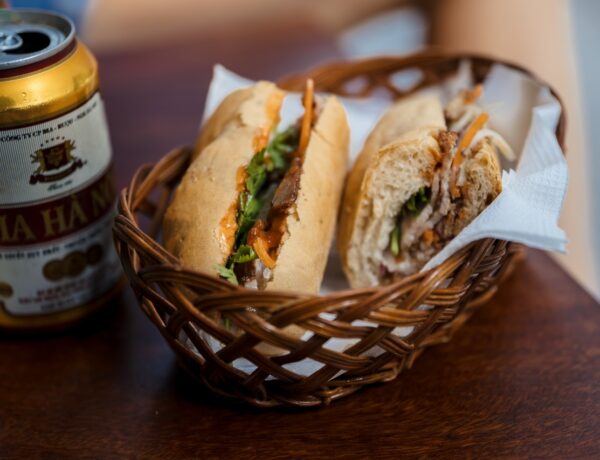Vietnamese have this old saying: “learn to eat, learn to speak, learn to open and end a conversation”. As you can see ‘learning to eat’ is a fundamental activity in every Vietnamese household. When it comes to having dinner or lunch with Vietnamese, there are many rules that you may not know. In this article, we will explain all the essentials in detail!
The Vietnamese ‘Dining Table’ Explained
To Vietnamese, the ‘dining table’ is a copper round tray called “mâm”. When having a meal, the family will put all dishes on this tray. It often includes rice, savory dishes, vegetable dishes, and soup. Everything should be nicely put together, with sauce bowls being in the middle.
Here’s a hidden fact: the round shape symbolizes reunion and happiness. Also, it is believed that this shape allows everyone in the family to sit around and strengthen their bond over the meal.
It is true that many Vietnamese households now enjoy modern dining tables and chairs. But sitting on a bamboo matt, surrounding the copper round tray will always remain symbolic.
How to Navigate Seating in a Vietnamese Meal
In a modern dining setting, the host and hostess often sit at the two ends. But in a traditional Vietnamese meal, everyone just sits around the tray. Each position in the circle is equal, and there is no upper, lower, front, or back.
In the past, it was the opposite. Males and females of the family sit separately. The men got to enjoy the meal in the dining room/living room, while the women and children gathered in the kitchen.
Nowadays, people tend to give guests or elders the ‘better’ seats, which are close to the best dishes. This act indicates respect to the elders, and hospitality to the guests – in true “make yourself at home” spirit.
Meanwhile, children have to sit close to the rice pot and take care of serving rice.
When invited to have a meal with a Vietnamese family, what should you do about the seating? Ask the host/hostess where you can sit. And if there’s an elder around, offer your seat to him/her.
How to Say “Bon Appetit” in a Vietnamese Meal
Vietnamese people do say “bon appetit” before each meal. But it’s not the famous French phrase as you know it. According to the old custom, before reaching for your bowl of rice and chopsticks, you must “invite” the older to enjoy the meal first. The younger invites the older first, and the oldest is invited first.
The right phrase to say is “con mời cơm + [pronoun]” (literal translation: I invite you to have rice. As you may know, rice is the main component of any Vietnamese meal. Hence, the word cơm (cooked rice) must be included.
If you want to leave the table after finishing your meal, you will need to repeat this phrase.
How to Have a Small Talk During a Vietnamese Meal
Small talks are a significant part of Vietnamese culture. It is an important opportunity for family members to catch up and make their bonding strong. Elders usually talk about family traditions and stories of the past. Meanwhile, younger members can share what is going on in their lives.
Overall, sharing happy stories, plans and asking about each other’s well-being are much encouraged.
On the other hand, you must avoid arguing, provoking negative emotions, or sad news. Plus, try not to talk during the entire meal to ensure hygiene and good digestion.
Master Vietnamese Chopsticks Etiquette
Chopsticks – a folk item that has been associated with many generations of Vietnamese people.
Knives and forks might appear more in Vietnamese meals today, but the chopsticks will forever be the utensil of choice.
When preparing for the meal, the younger is in charge of handing out chopsticks for everyone. If you’re asked to do that, pay attention to placing the chopsticks in the right direction. The smaller ends of chopsticks need to point towards the center of the tray. After the meal, put the chopsticks down neatly.
During the meal, remember the following:
- Don’t take the food straight from the plate to your mouth with your chopsticks. First, place it in your bowl, then enjoy the food.
- Don’t use chopsticks to stir up the plate or the soup bowl.
- Don’t use chopsticks to select a piece of food.
- Don’t stick the tip of the chopsticks upright.
- Don’t suck the chopsticks.
- Don’t dip the tip of the chopsticks into the sauce bowl.
- If others offer you food, don’t receive it chopsticks to chopsticks.
Also, Vietnamese people love to offer food to guests. If you want to do the same, use the clean ends of your chopsticks.
Have a Drink in a Vietnamese Meal
Having a drink during lunch or dinner is very common in Vietnam. Oftentimes, people drink water during the meal.
When it comes to drinking alcohol, hard liqueurs aren’t a favorite. Instead, people go for something smooth with a lower percentage of alcohol like rice wine, or beer. Plus, the point here is to enjoy the meal, not to get drunk. Therefore, drink in moderation if you’re offered a glass of rice wine or a can of beer. Of course, children aren’t allowed to touch any alcoholic drinks.
After the meal, people gather around having tea and enjoying desserts or fruits. You will also notice that children often have to invite elders to have fruits before they do. And if you’re a guest, the host/hostess will also offer you tea and fruits first. Remember to say thank you, sip the tea slowly and enjoy the fruits!
References:
Cover photo: https://genvita.vn



No Comments